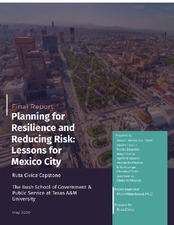| dc.contributor.advisor | Hilderbrand, Mary | |
| dc.creator | Alexander-Hawk, Mason | |
| dc.creator | Davis, Rachell | |
| dc.creator | Doucette, Patrick | |
| dc.creator | Garcia, Abigail | |
| dc.creator | Hill-Jackson, April | |
| dc.creator | Khunjua, Aleksandre | |
| dc.creator | Koeniger, Erika | |
| dc.creator | Pineiro, Christian | |
| dc.creator | Sanchez, Joey | |
| dc.creator | Winarski, Kimberly | |
| dc.date.accessioned | 2020-08-19T16:10:26Z | |
| dc.date.available | 2020-08-19T16:10:26Z | |
| dc.date.issued | 2020 | |
| dc.identifier.uri | https://hdl.handle.net/1969.1/188692 | |
| dc.description | Disaster risk management (DRM) has never been as essential to Mexico City as today. Three years ago, the city was hit with its largest earthquake in over 30 years. It killed 219 people, caused billions of dollars in infrastructure damages, and left a vibrant city in disarray. While Mexico City and its surrounding communities continue to recover, the aftermath of the earthquake confronts its residents, businesses, and local leaders daily. | en |
| dc.language.iso | en_US | |
| dc.rights | Attribution-NonCommercial-NoDerivatives 4.0 International | en |
| dc.rights.uri | http://creativecommons.org/licenses/by-nc-nd/4.0/ | |
| dc.title | Planning for Resilience and Reducing Risk: Lessons for Mexico City | en |
| dc.type | Technical Report | en |
| dc.contributor.sponsor | Client | |
| local.department | Public Service and Administration | en |



